Shar-Peis are one of those dogs whose appearance won’t leave you indifferent. Their wrinkly skin and folds with a broad hippopotamus muzzle make for a powerful look, but deep down, they’re sweethearts like no others. Aside from their kind personalities, Chinese Shar-Pei colors are another thing to admire.
As the American Kennel Club states, Chinese Shar-Pei colors come in 18 standard varieties. These include apricot dilute, black, black sable, blue, blue dilute, brown, chocolate, cream, cream dilute, cream sable, fawn, fawn sable, five-point red dilute, isabella dilute, lilac dilute, red, red fawn, and red sable.
The non-standard colors are blue sable, brown sable, and white.
Now, you can’t say you have no choice when it comes to Shar-Pei dogs. There is a color suited to anyone’s liking. What’s your choice gonna be? A standard or unique Shar-Pei color?
About The Chinese Shar-Pei
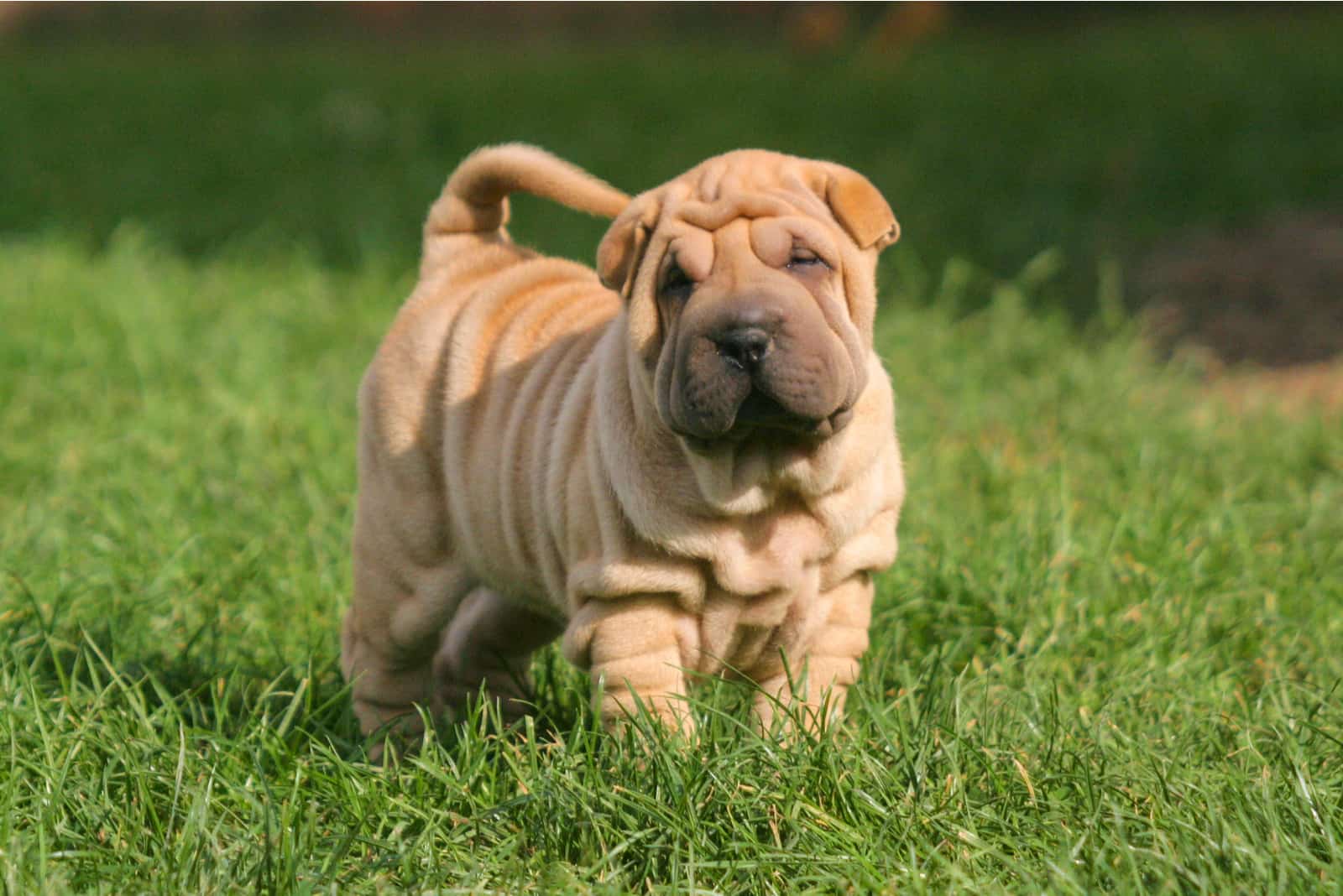
The Shar-Pei means sand skin in Chinese. This absolutely describes their unique coat look.
Add a hippopotamus head, small sunken eyes, a blue-black tongue, and a scowling expression, and you’ll get a pup that looks like it doesn’t belong on earth. It is a curious fusion of unusual physical characteristics.
According to the Shar Pei growth chart, this is a medium-sized dog, sturdily-built, that stands from 18 to 20 inches and weighs between 45 and 60 pounds.
Their look is amazing, but their history is even cooler!
Just like the Chow Chow and the Pug, the Shar-Pei is a distinctly purebred Chinese dog. They go back more than 2,000 years to the Han Dynasty.
This smart, rugged dog was once a peasant’s dog. The Shar-pei performed many roles: hunter, herder, guard dog, watchdog, and fighting dog.
When the communist regime took over China in 1949, they slaughtered much of the dog population. Luckily, a few of these dogs survived in Hong Kong and Taiwan.
If it weren’t for a Hong Kong breeder named Matgo Law, a magazine photo, and the urge of the Americans, we wouldn’t have Shar-Peis today.
And that would be simply sad.
Soon enough, the western world found out about these amazing dogs, and a breed club was founded in 1974: the Chinese Shar-Pei Club of America.
The rest? History.
Does Canine Color Matter?
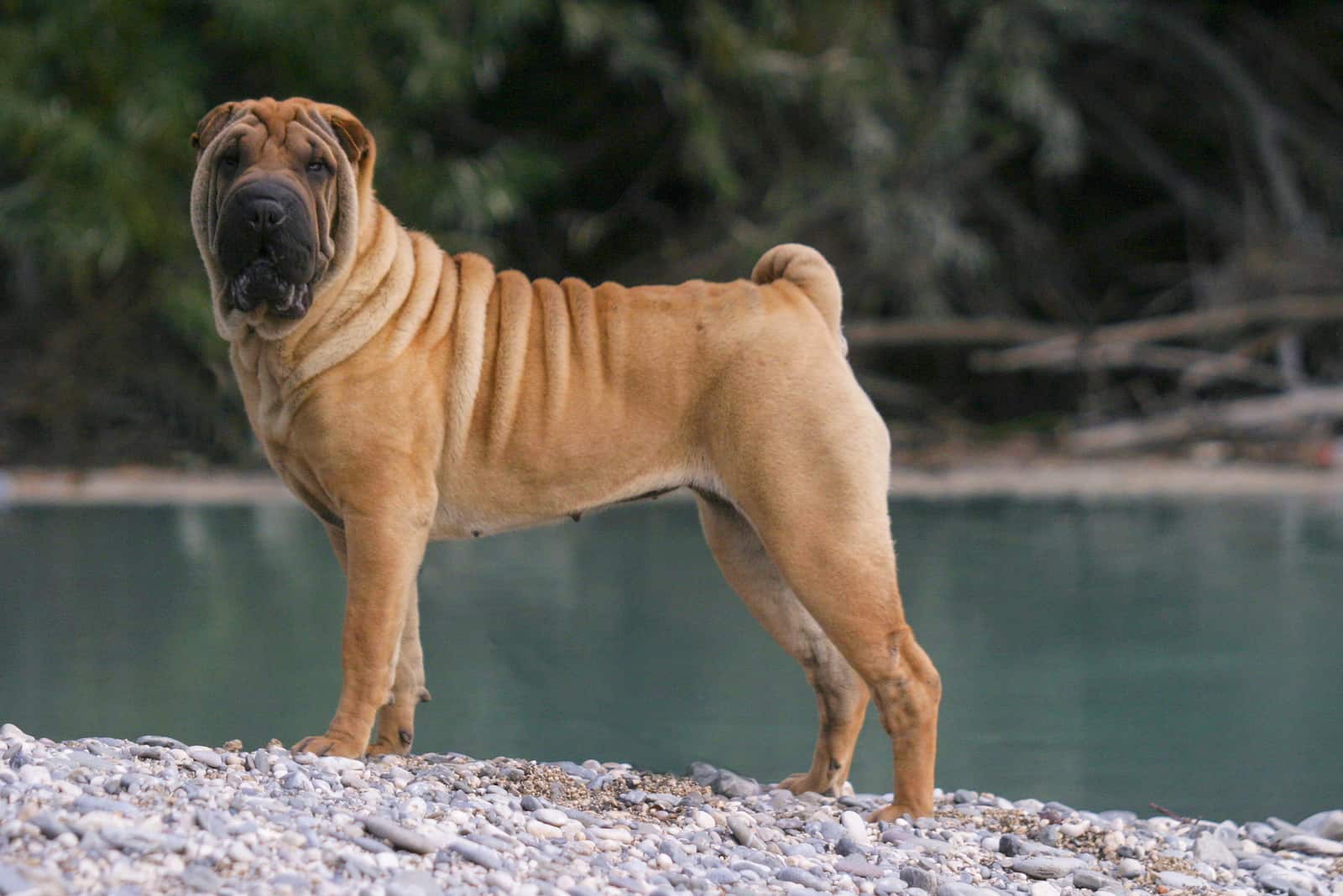
Many breeders will claim that canine coat color doesn’t matter. However, there’s much recent scientific evidence that proves them wrong.
For example, according to a University of Sydney study, recessive color genes cause health problems in some dog breeds, usually chocolate-colored dogs with a lower life expectancy than their other colored cousins.
Such dogs have a two to four times higher chance of suffering from otitis externa or ear inflammation and pyotraumatic dermatitis. This is almost similar to white and merle dogs suffering from deafness and underdeveloped olfaction ability.
This isn’t to discourage you from getting a specific Shar-Pei color. It doesn’t have to mean your dog will suffer from color-related health issues.
Standard Chinese Shar-Pei Colors According To Kennel Clubs
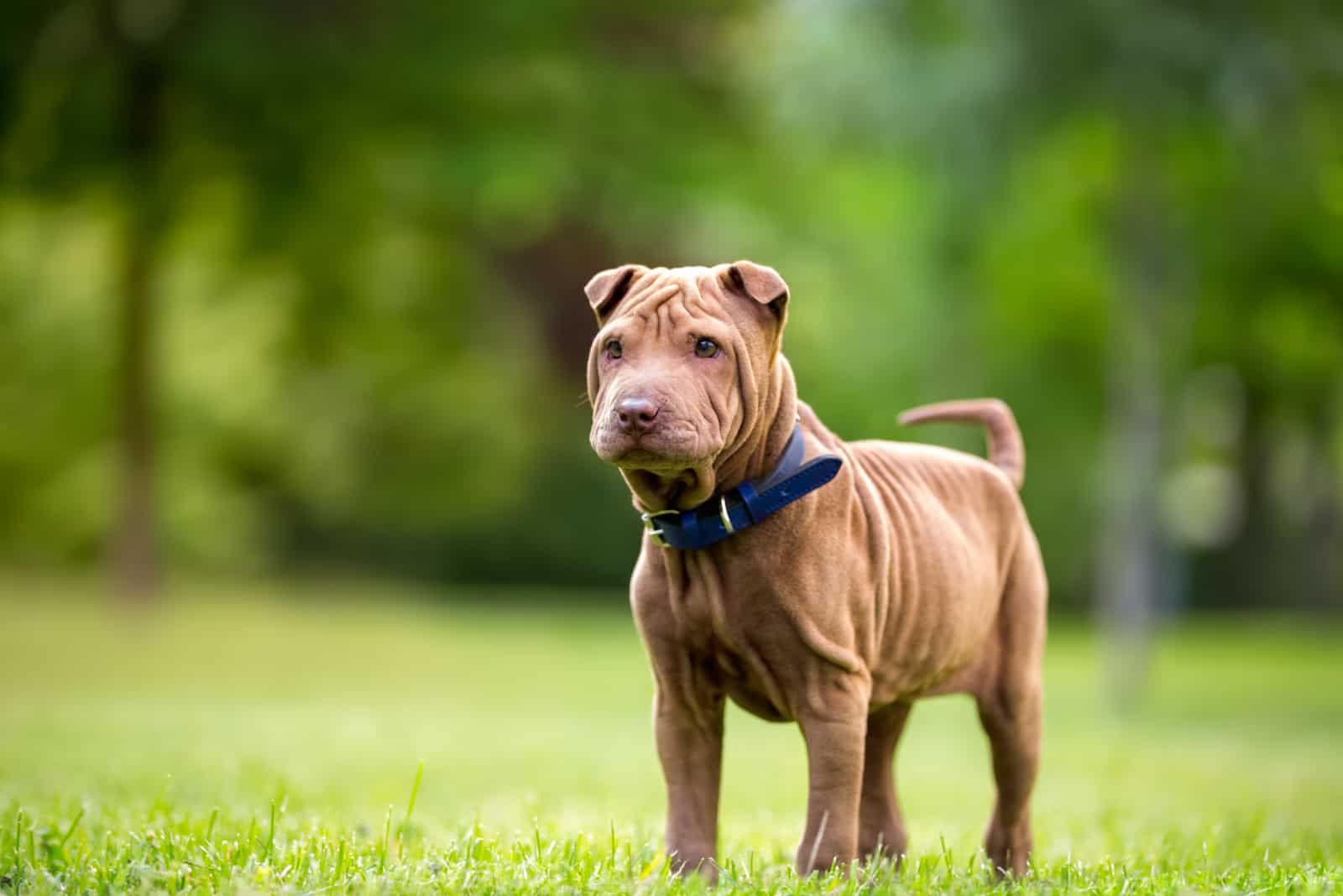
The best source to identify Shar-Pei colors is by consulting breed standards published by the AKC, CKS, UKC, or FCI.
Here you have an extract from the Shar-Pei standard:
American Kennel Club (AKC) recognized colors are:
• apricot dilute,
• black,
• black sable,
• blue,
• blue dilute,
• brown,
• chocolate,
• cream,
• cream dilute,
• cream sable,
• fawn,
• fawn sable,
• five-point red dilute,
• isabella dilute,
• lilac dilute,
• red,
• red fawn,
• and red sable.
However, blue sable, brown sable, and white are considered non-standard coat colors. The Canadian Kennel Club (CKC) accepts sable. The United Kennel Club (UKC) accepts any solid color or sable. Solid colors may also have darker shading on the ears and down the back.
The Fédération Cynologique Internationale (FCI) accepts all solid colors but white. Darker shading on the ears is permissible. Tail and rear thighs are mostly lighter.
Chinese Shar-Pei Standard Coat Color Variations
Chinese Shar-Pei colors marked as standard are allowed to join dog shows because they conform to the exact description of the breed.
You can find descriptions of the standard 18 coat colors below.
Apricot Dilute Shar-Pei
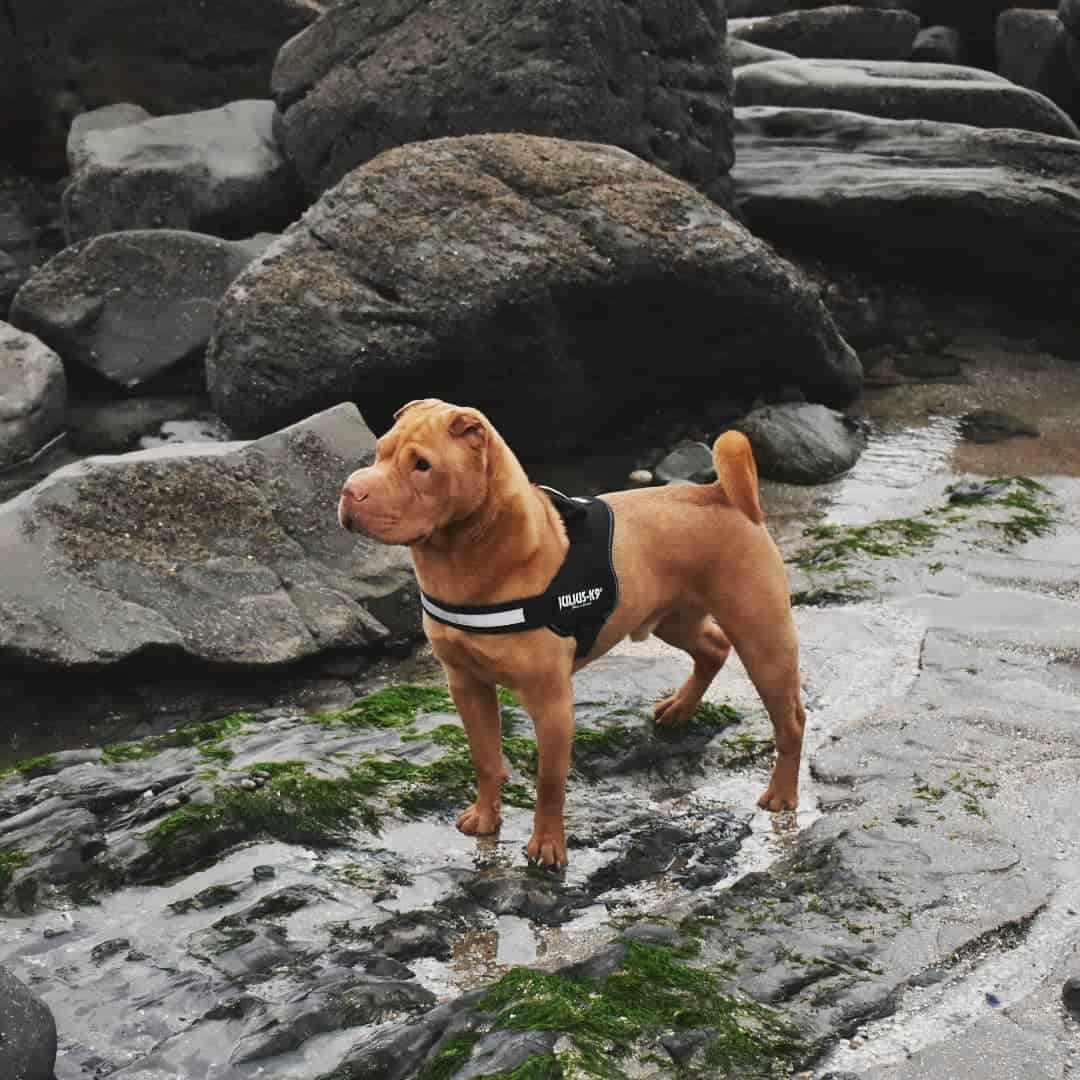
Photo from: @thor_peiby
The apricot dilute Shar-Pei has a light orange or yellow coat similar to the inside of a ripe apricot. This color variation is also described as dilute because instead of having black pigmentation on their nose, nails, and fur, they are self-colored or have pinkish points.
Black Shar-Pei
Black Shar-Peis have a solid black coat. It’s unusual for them to have white patches on their skin like other dog breeds have. This highlights their hippo-like traits, making them appear like a funny cross between a dog and an aquatic animal.
Black Sable Shar-Pei
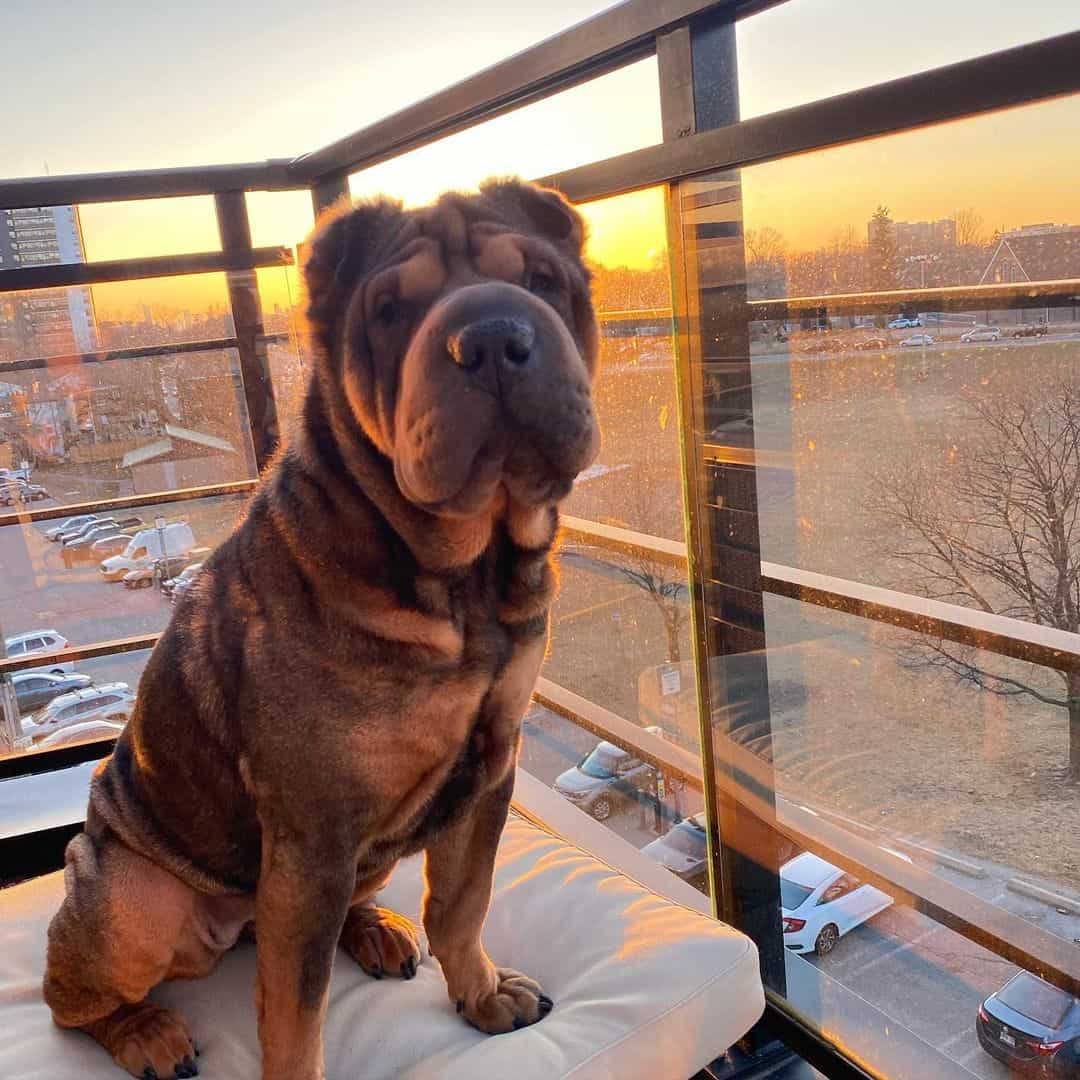
Photo from: @sharpeibowie
A black sable Shar-Pei has a light color base and a black-tipped coat. These dogs appear darker than other sable variations because of the number of toppings their coat has.
Blue Shar-Pei
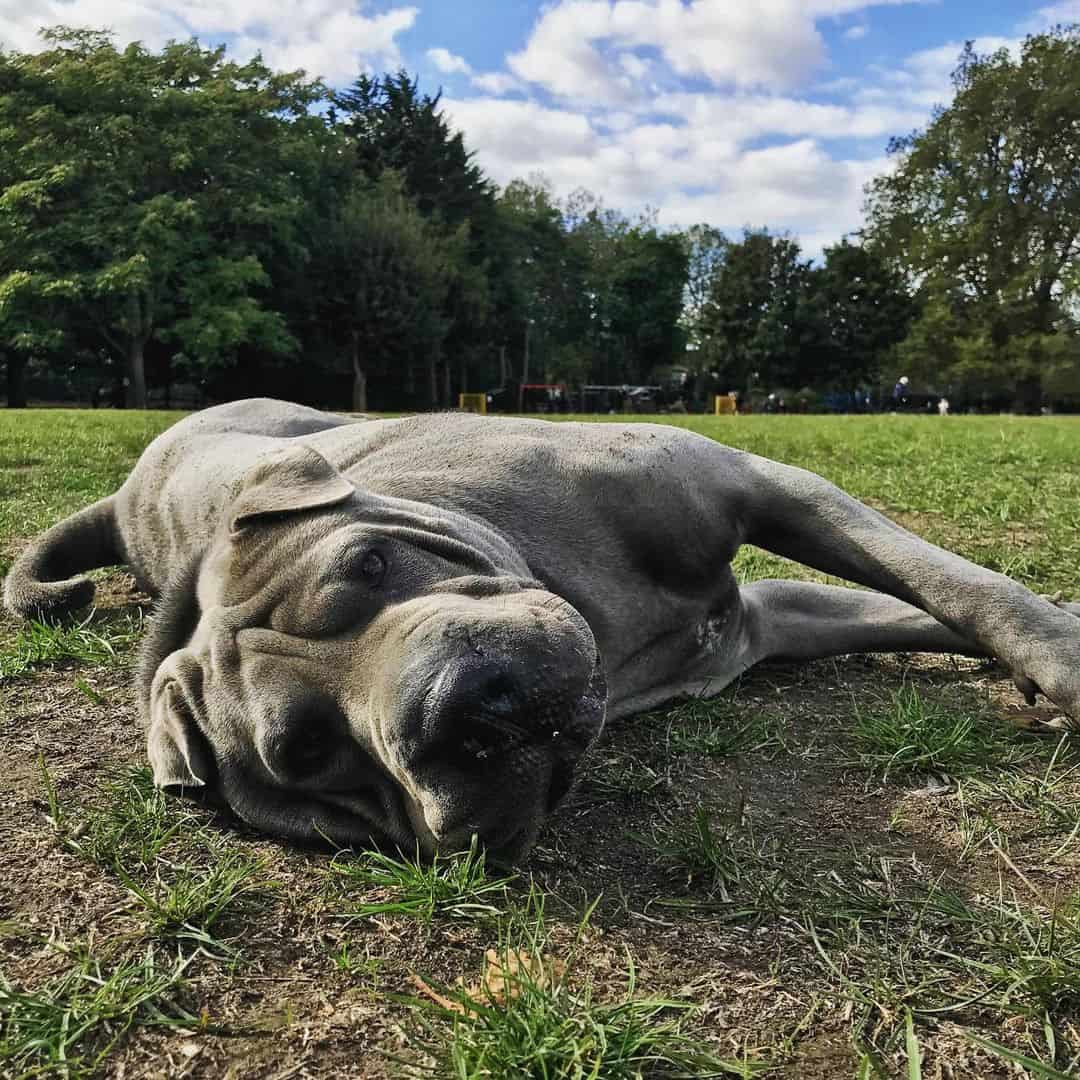
Photo from: @dogandbonesociety
Blue Shar-Peis aren’t really blue – they’re more charcoal gray in color. Blue Shar-Pei dogs have dark pigmentations on their noses, nails, and some body parts, which sets them apart from the blue dilute Shar-Pei.
Blue Dilute Shar-Pei
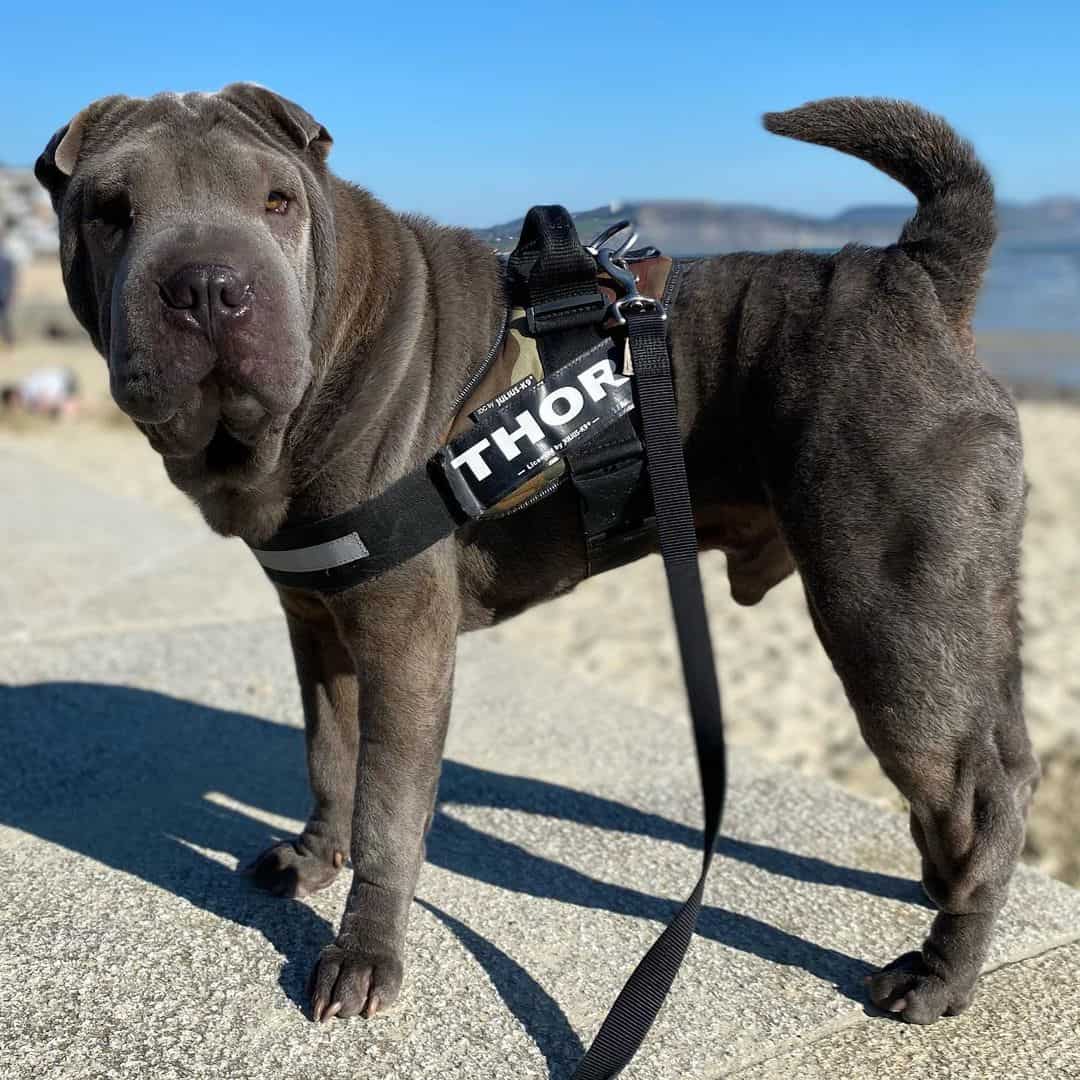
Photo from: @thehandsomehippo
A blue dilute Shar-Pei sports a stunning charcoal gray coat. But, instead of having black or dark pigmentation on their body, they are self-colored. The nose and nails are a similar shade to their coat or have a pinkish tint because of the dilution gene.
Brown Shar-Pei
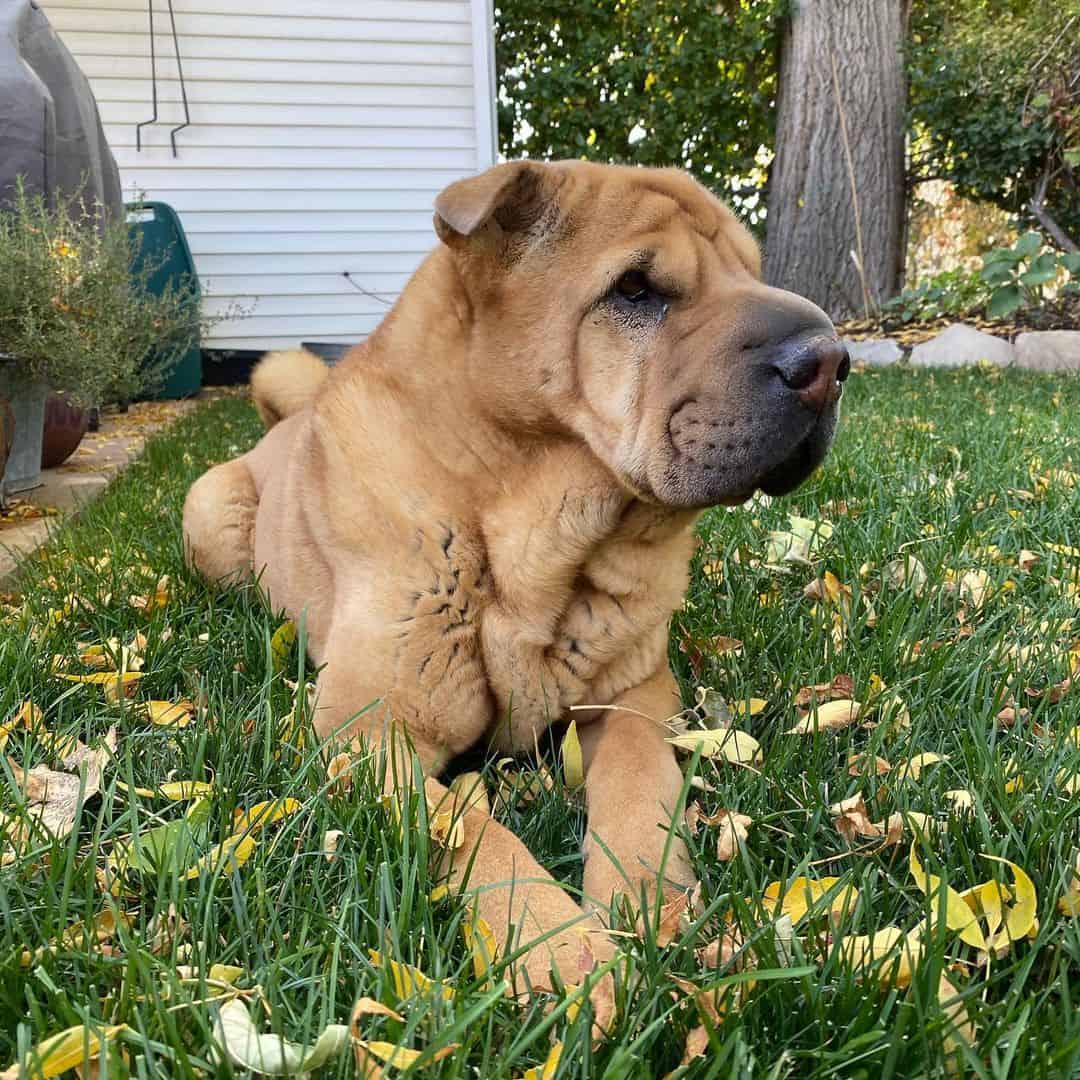
Photo from: @sharpeibrodie
Brown Shar-Peis are brown because of the recessive gene that changes the black color of the eumelanin. They’re not as dark as chocolate or liver Shar-Peis, but they still look stunning. Their noses, nails, and other body parts also have some black pigmentation.
Chocolate Dilute Shar-Pei
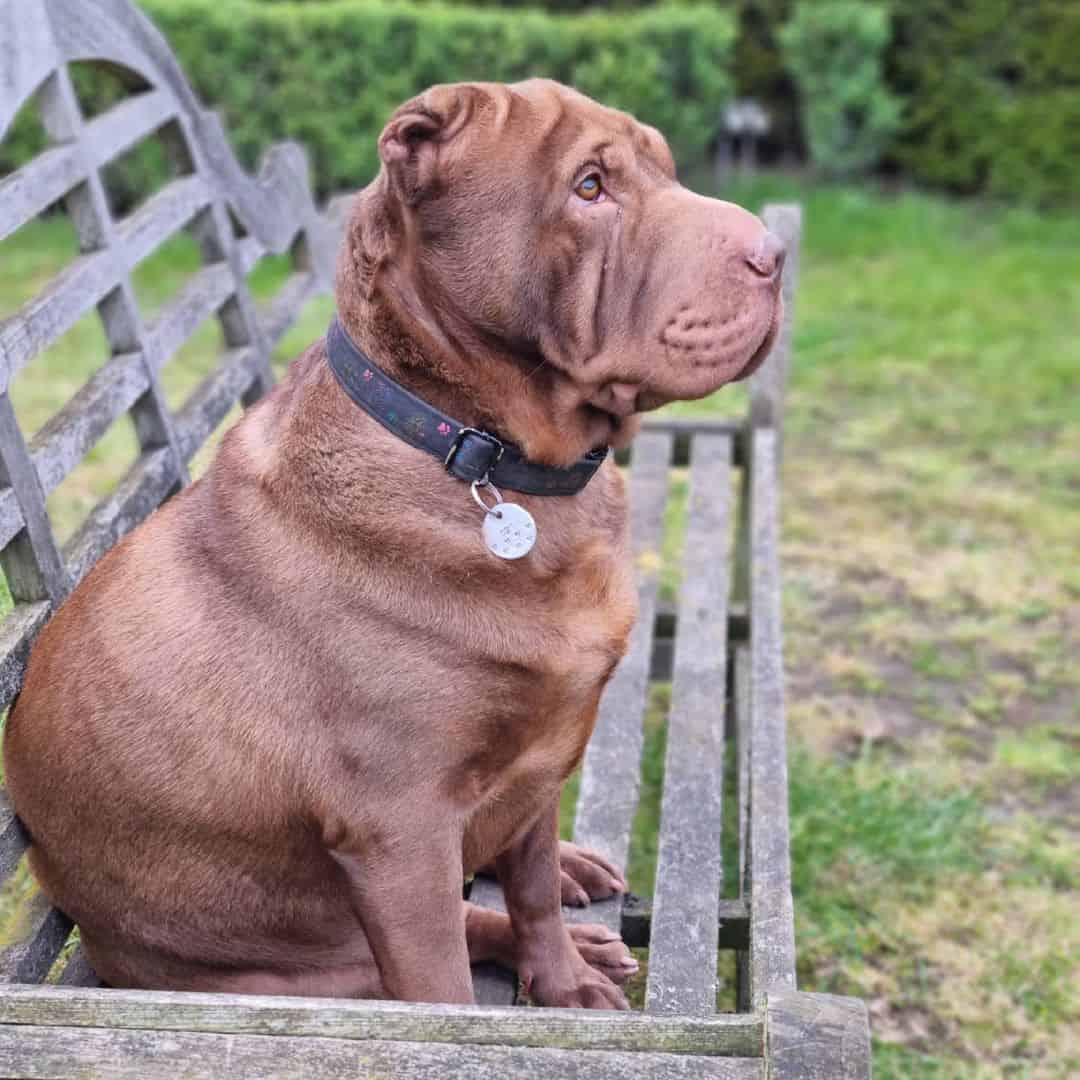
Photo from: @semthesharpei
A chocolate dilute Shar-Pei resembles a teddy bear a lot. Because of specific genes that control pigment production on their coats, they are darker and richer in color than brown Shar-Peis. These dogs are also self-colored, so you won’t see any dark marks or spots on their bodies.
Cream Shar-Pei

Photo from: @my_paws_and_me
Cream Shar-Peis have a medium yellow coat, lowly saturated. They only have a bit more color than white Shar-Peis, so don’t mistake these two. A true cream Shar-Pei has black pigments on their body, so they’re not fully cream.
Cream Dilute Shar-Pei
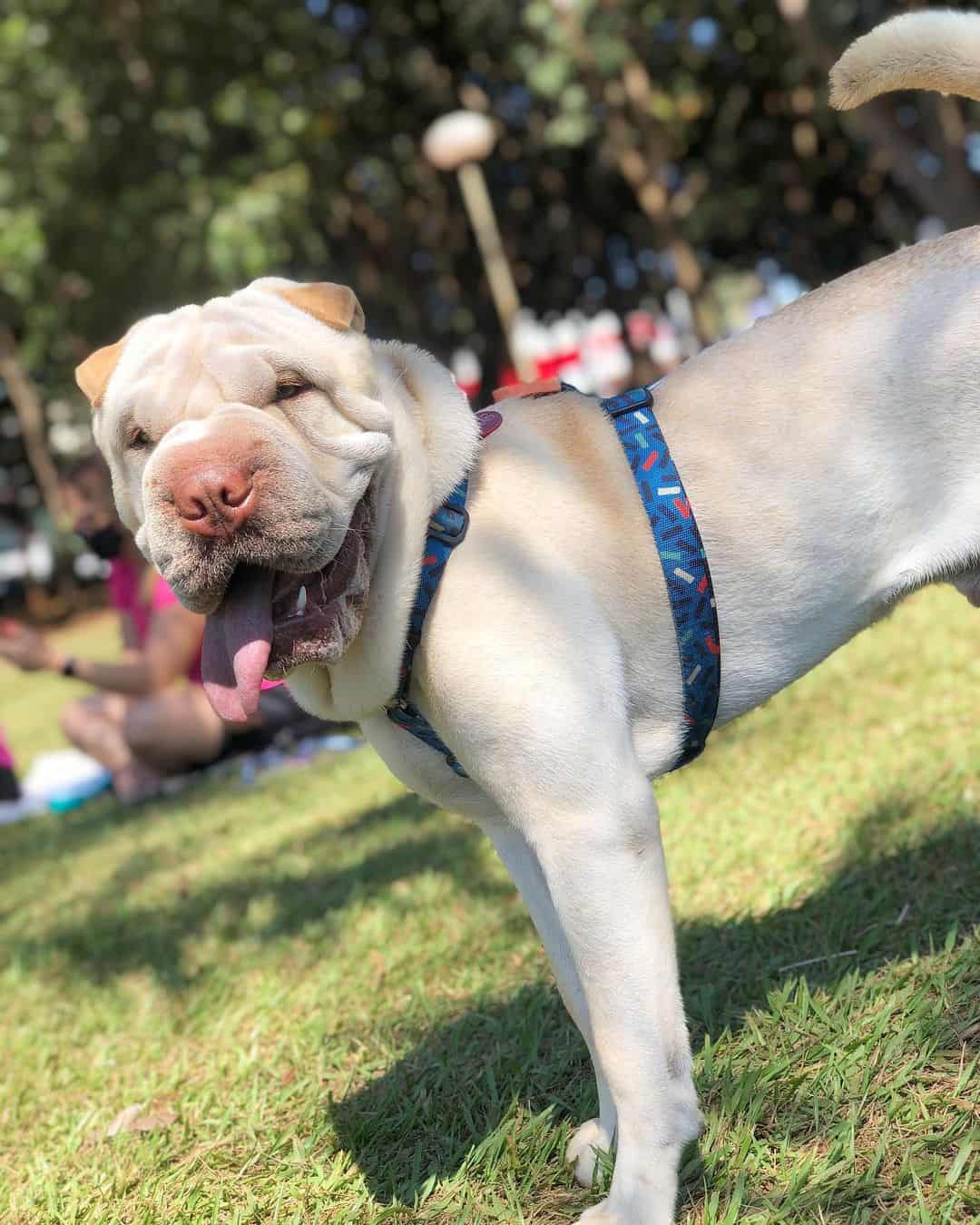
Photo from: @sharpeinicolau
A cream dilute Shar-Pei also has a light, medium yellow coat. What they don’t have is the dark pigment on their body. Their noses and nails are usually pink in color.
Fawn Shar-Pei
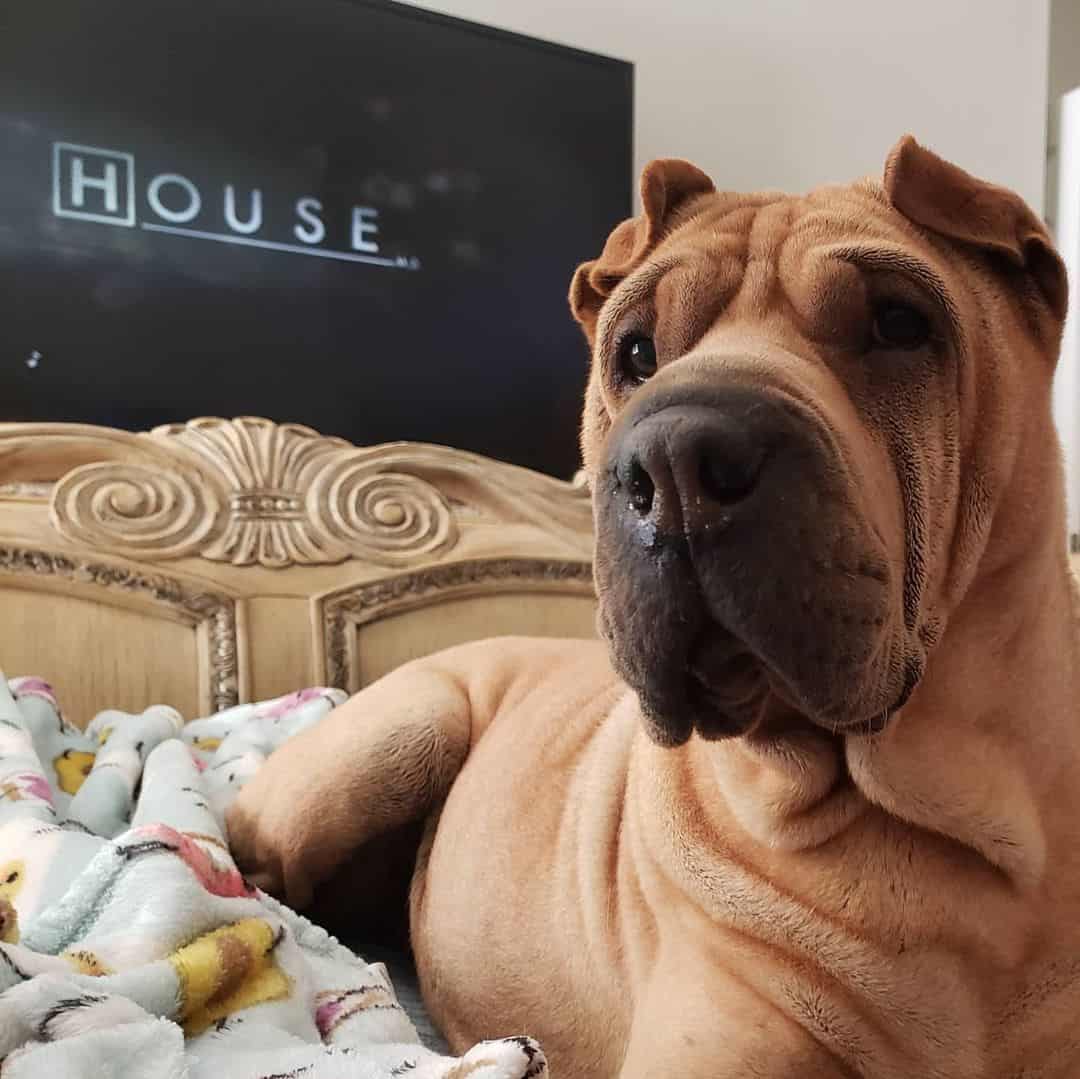
Photo from: @house_of_pei
Fawn Shar-Peis are quite incredible with their medium red-yellow hue. Their noses and nails are heavily tinted in black, as well as their eye rims.
Five Point Red Dilute Shar-Pei
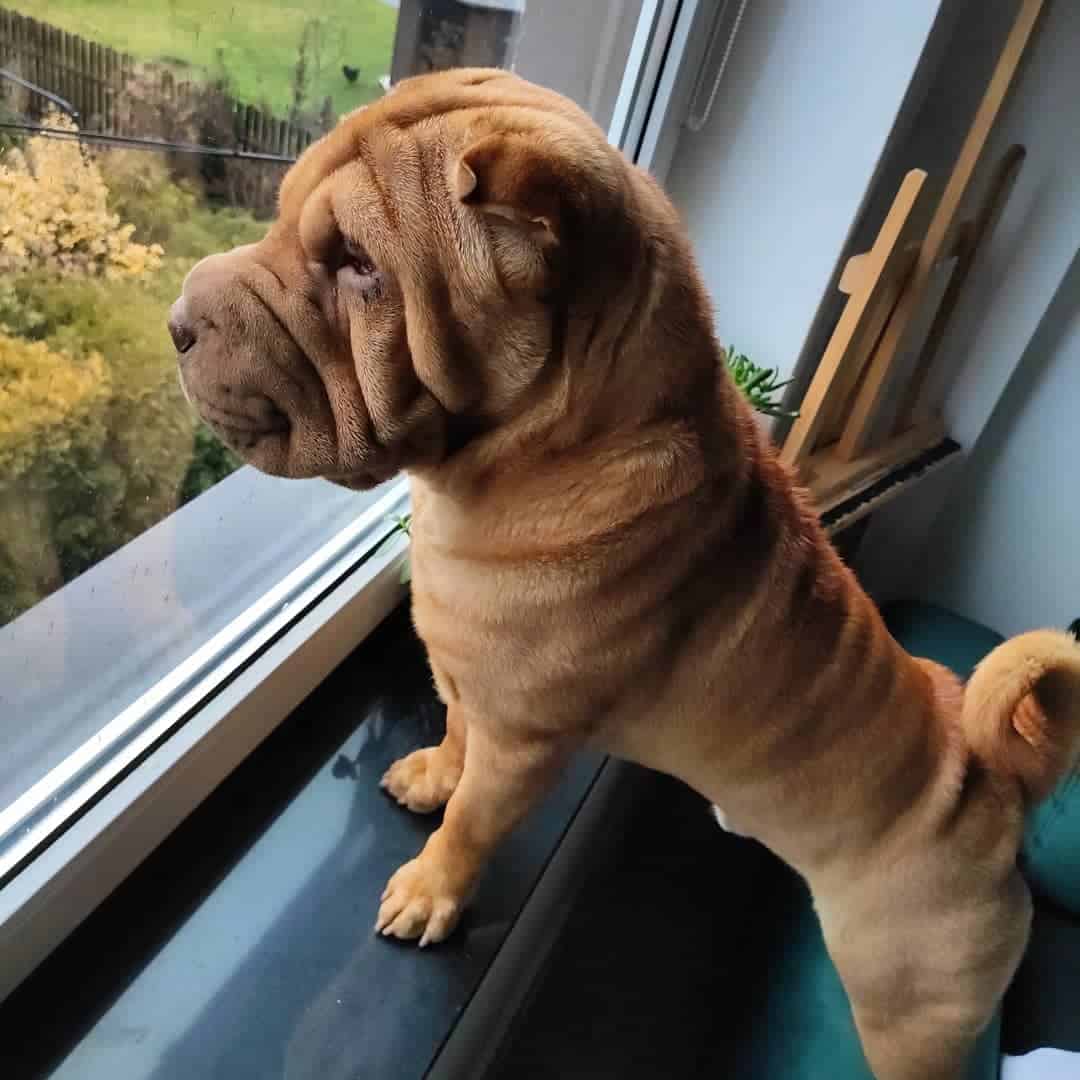
Photo from: @kevin_sharpei
Chinese people believe five-point red Shar-Peis are lucky pets because they are thought to bring prosperity and growth. But, why are they called five-point red? It’s because the area around the eyes, nose, tongue, paws, and anus are reddish in color. Their base coat is deep red fawn.
Isabella Dilute Shar-Pei

Photo from: @yourfureverk9s.uk
The AKC does use the term isabella to describe the color of this dog, but this is nothing but a dilute fawn Shar-Pei. These dogs don’t have any dark points on their bodies, and the nose and nails are usually pinkish or self-colored.
Lilac Dilute Shar-Pei
A lilac dilute Shar-Pei looks as if it has a coat that’s dusted with a tint of purple. This dog is actually twice diluted. First, by the chocolate gene, and then by the blue gene. Since they’re dilute, you can expect them to have the nose, nails, and the area around the eyes self-colored or pinkish.
Red Shar-Pei
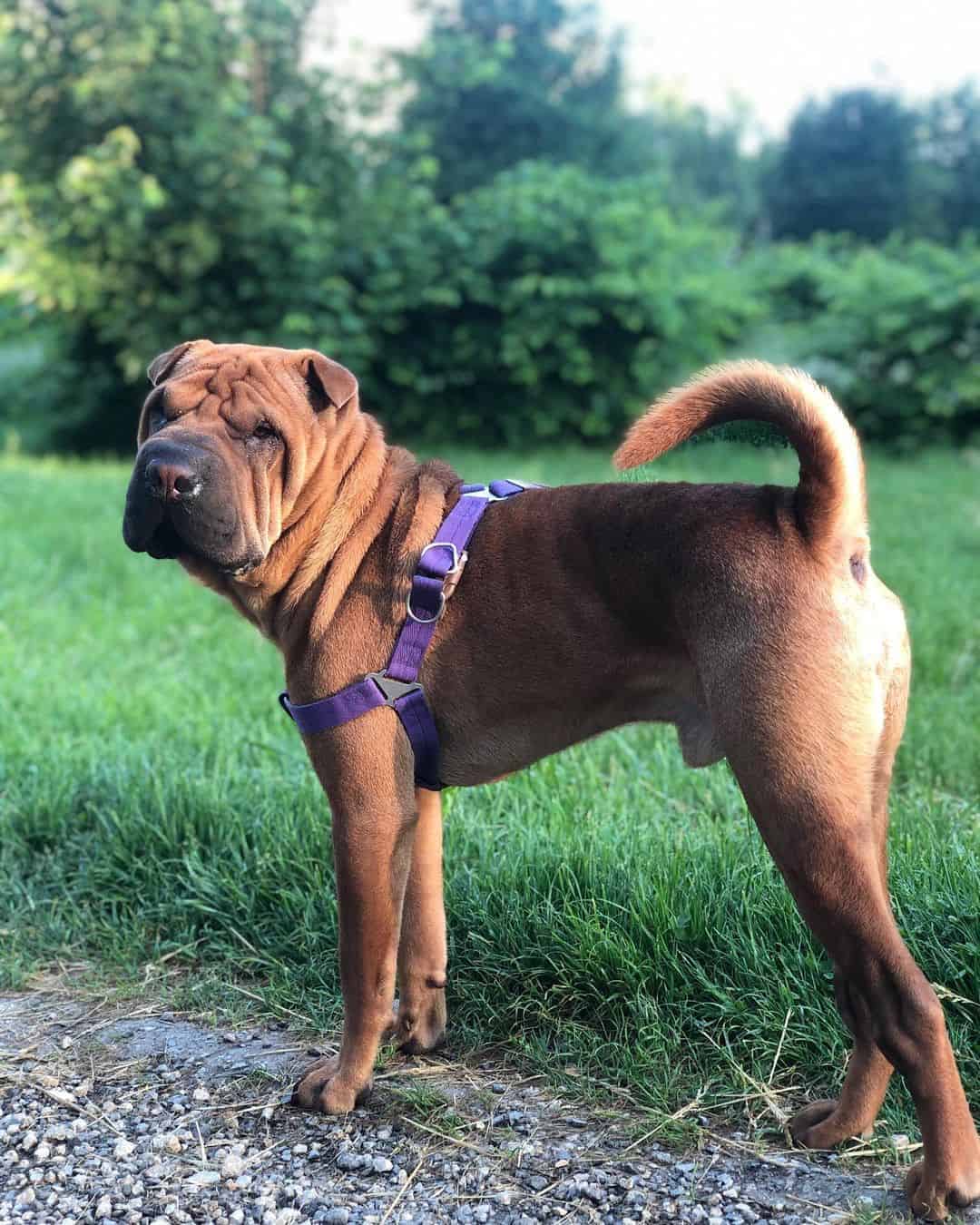
Photo from: @vasko.jpg
Solid red is one of the most common Chinese Shar-Pei colors. The concentration of the red coloration will vary depending on the genes. They have noticeable dark marks all over their faces, but sometimes even on their nails and footpads!
Red Fawn Shar-Pei
Red fawn Shar-Peis are exactly what their name says. They’re not quite red, but they’re also not quite fawn either. Their color is somewhere in between these two. Some of these pups may have dark pigmentations on their bodies.
Cream Sable Shar-Pei
Cream sable Shar-Peis have a medium yellow base coat with black tippings. These Shar-Peis aren’t as common as the solid cream ones or cream dilute versions. Still, they’re quite lovely and worth having.
Fawn Sable Shar-Pei
Fawn sable Shar-Peis have a red-yellow base coat and black toppings. This makes them appear darker than most fawn puppies. Fawn sable Shar-Peis have black pigmentations on their bodies, mostly on the nose and nails.
Red Sable Shar-Pei
Red sable Shar-Peis have a red base with black-tipped hair. Also, they can have some black areas on the body. If they don’t have many black-colored tips, they may resemble solid red Shar-Peis.
The Non-Standard Shar-Pei Colors
The Chinese Shar-Pei colors labeled as non-standard are not allowed to enter conformation shows because their coats are not what’s expected from the breed. However, they can still participate in agility competitions and other non-sporting shows.
Down below, we have listed the non-standard Shar-Pei Colors.
White Shar-Pei

Photo from: @_03_08_20_
White Shar-Peis do exist. But, don’t mistake them for albino dogs because these don’t lack pigmentation. White Shar-Peis aren’t purely white; they’re more cream in color.
Blue Sable Shar-Pei
Blue sable Shar-Peis have charcoal gray hairs, but their hair tips are black. What differentiates them from other blues is that they’re relatively darker due to their tipping.
Brown Sable Shar-Pei
Brown sable Shar-Peis are generally brown in color with black hair tips. This coat color is different from liver or chocolate because it’s much lighter, even if they’re black-tipped.
Another disallowed color by the AKC is the flowered Shar-Pei. It’s a lovely variation of a white base sprinkled with colored spots and ticking. Also, the AKC doesn’t recognize the saddle pattern in Shar-Peis.
What Is A Dilute Shar-Pei?
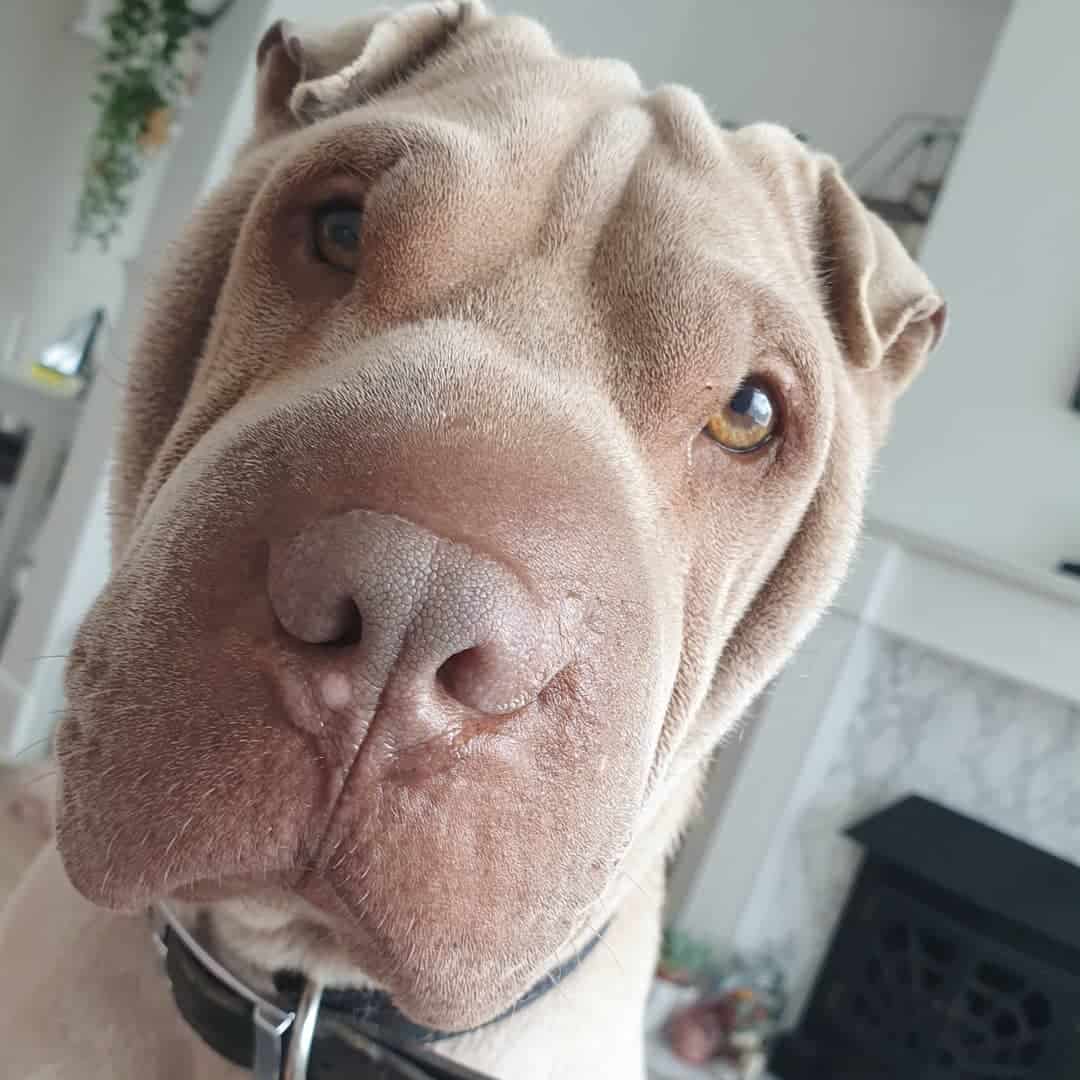
Photo from: @kerwissymac
We’ve mentioned the word dilute several times already, but do you really know what it means? You probably have a general idea, but let’s explain things in more detail.
Dilute Shar-Peis don’t have black tones on their coats like standard Shar-Peis do. Instead, the pigmentations found on their skin, noses, and nails are either self-colored or pinkish.
When we say self-colored, we mean that those body parts conform to the dog’s base coat. For example, if the coat is blue/gray, the nose, nails, and all other areas of the skin will be gray too.
The reason behind this dilution is mainly because some genes alter the concentration of eumelanin and pheomelanin.
The Rarest And Most Common Colors Of Shar-Peis
Shar-Pei dogs aren’t that common. They cost a pretty penny, but finding a good breeder that takes care of them well is also difficult.
Just imagine how hard it would be to find a five-point red dilute Shar-Pei!
To help you out with finding your ideal Shar-Pei, here’s a list of common and rare Chinese Shar-Pei colors:
| Common Shar-Pei Colors | Rare Shar-Pei Colors |
|---|---|
| Fawn (light to dark) | Blue sable |
| Red fawn | Brown sable |
| Fawn sable | White |
| Red | Five-point red dilute |
| Cream | / |
| Black | / |
| Blue sable | / |
Shar-Pei Coat Genetics: How Come They Have So Many Coat Colors?
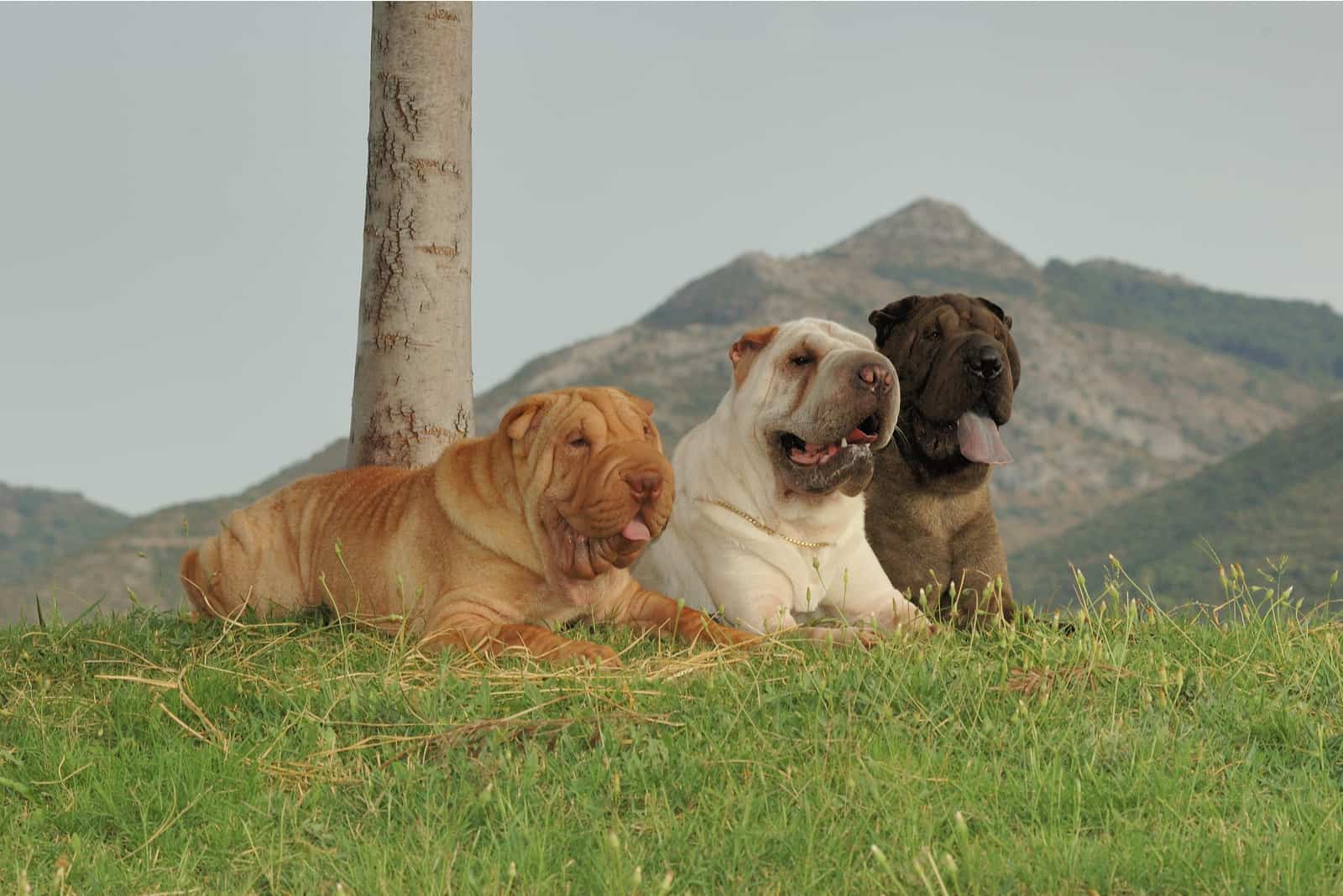
Shar-Peis have two essential pigments named eumelanin and pheomelanin. Some genes modify the production of these pigments, which results in a rainbow of coat colors.
Eumelanin is a black pigment. Besides its dark shade, other colors can be created, a standard for many dog breeds.
For example, the tyrosinase-related protein 1 or brown gene modifies eumelanin and turns it into a brown or chocolate shade. On the other hand, beta-defensin is found to produce solid black dogs.
The other pigment, pheomelanin, affects the dog’s coat color. This is a red color by default but can also produce yellow, orange, and gold shades when altered by the dilution gene or MLPH (melanophilin).
This exact gene affects eumelanin production and gives Shar-Peis light-colored eyes, noses, and nails.
Do Coat Colors Affect Shar Pei’s Health And Behavior?
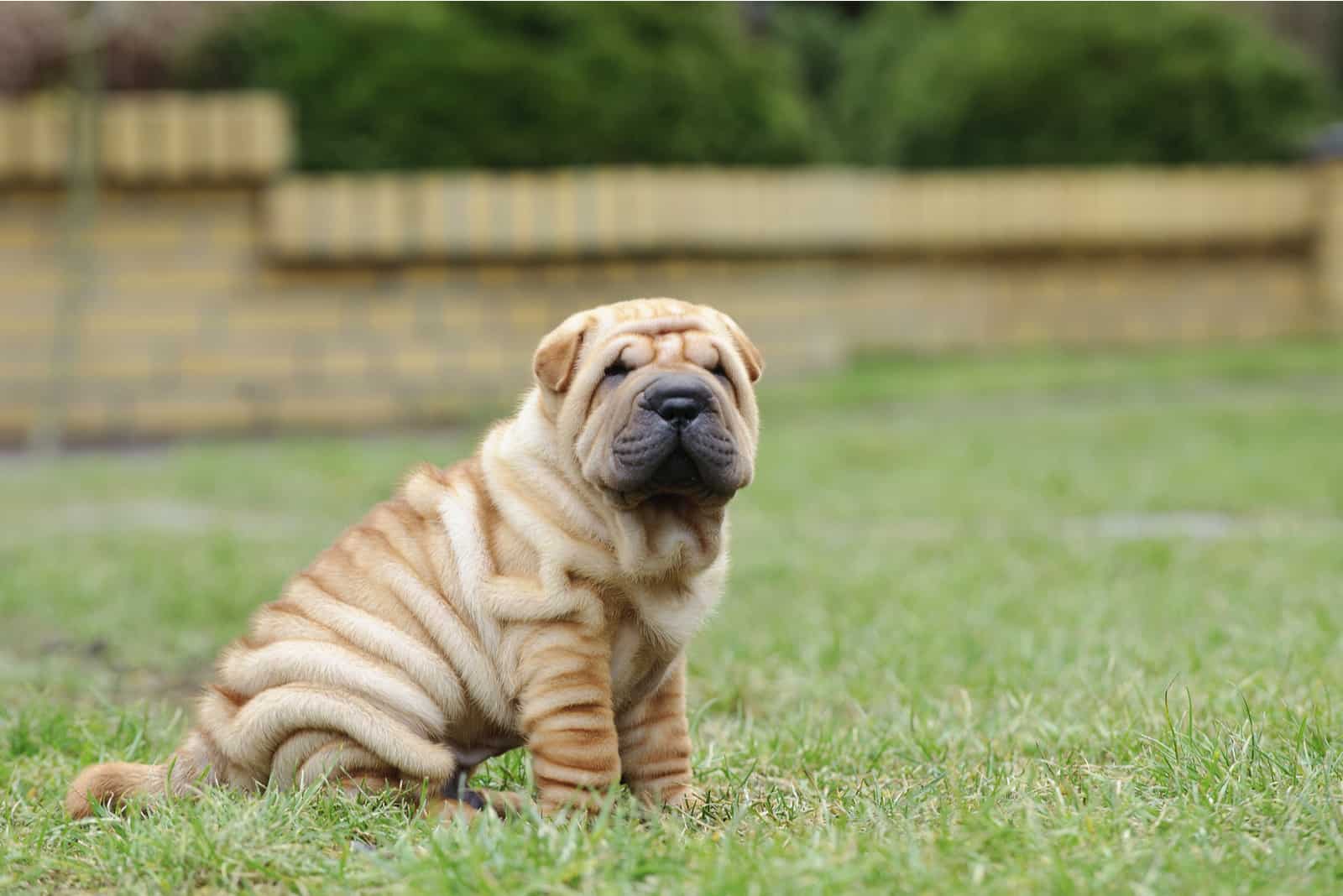
While we can’t prove a dog’s coat color is linked to behavioral issues, we can prove some coat colors affect the overall health status. Dilute Shar-Peis and brindles are more prone to some health issues than other Shar-Peis.
Here are the most common health issues specific Chinese Shar-Pei colors can suffer from:
• Ear inflammation (otitis externa). Ear inflammation is most common among chocolate Shar-Peis. The main symptoms of this condition are headshaking, scratching, swelling, a foul odor, and skin redness.
• Hot spots (pyotraumatic dermatitis). Another health condition that strikes mostly chocolate Shar-Peis. These hot spots are usually composed of inflamed lesions on the skin.
• Color dilution alopecia. This health problem is common among dilute Shar-Peis, especially blue-colored ones. The main symptoms include flaky or itchy skin and hair thinning.
• Black hair follicular dysplasia. Here’s another health issue mostly seen in dilutes. The typical targets are Shar-Peis with black hair and the areas with black pigmentation. These dogs experience hair loss.
Other health issues may include Shar-Pei fever (a condition of recurring fever and swelling of the hocks), glaucoma, entropion, hip dysplasia, etc.
Do Shar-Pei Puppies Change Color As They Grow?
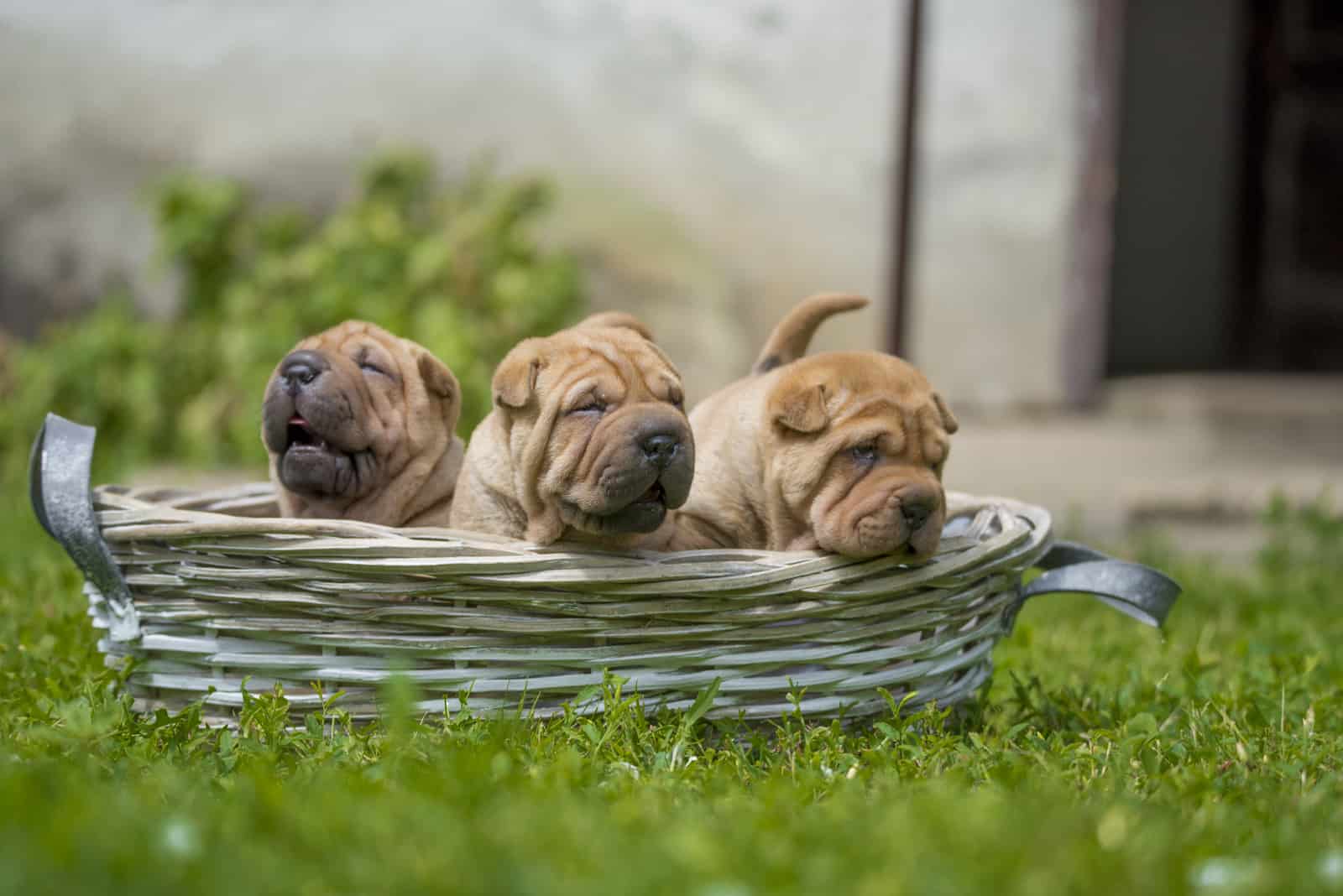
A Shar-Pei’s skin and coat can go through color transitions as the dog ages. But, this doesn’t mean your black Shar-Pei will magically turn red.
These color changes are subtle and mostly because of the pigment progression. So, if your light brown puppy turns chocolate, it’s absolutely normal.
Dogs can also manifest color changes if they’re exposed to the sun too much. This is also something you don’t have to worry about – no matter how hard some claim it’s because of thyroid problems.
Chinese Shar-Pei Eye Color
Besides their coat, the Shar-Pei’s eyes, nose, and tongue are also affected by some genetic variations.
As for eye colors, the AKC prefers dark-colored but dilute dogs with lighter eyes. The CKC thinks dark brown is ideal, but dilute dogs can have light eyes. The UKC also claims dark brown is ideal and dilutes with light eyes are okay. The FCI confirms all of the above.
Chinese Shar-Pei Nose Color
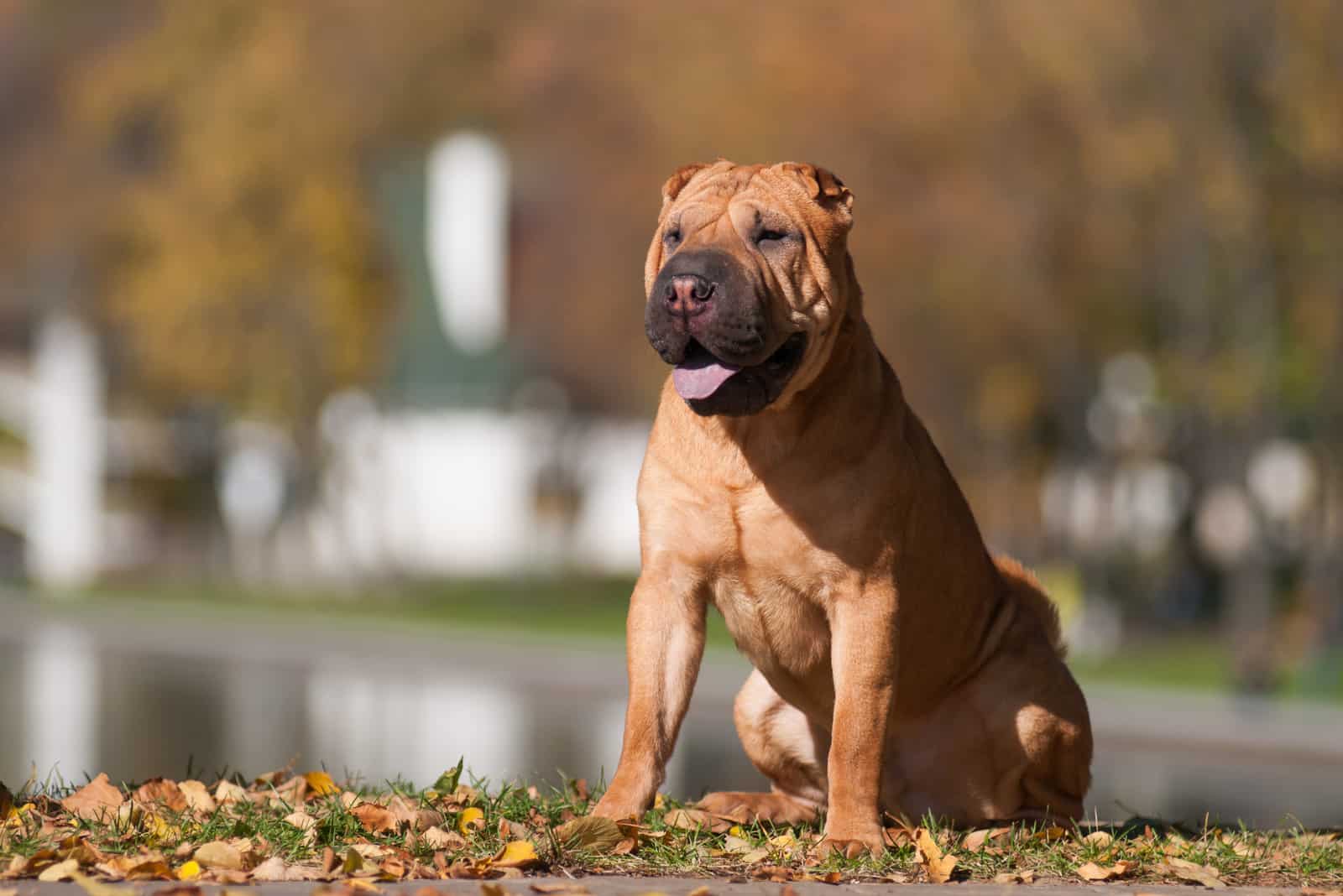
As for the nose color, the AKC prefers black, but any color is okay as long as it conforms to the dog’s general coat color. Dilutes ideally have a self-colored nose, while creams usually have light pigment in the center of the nose.
The CKC shares the same stance as the AKC.
The UKC says black Shar-Peis should have black noses, as well as reds and fawns. Dilute dogs should have a self-colored nose, while cream Shar-Peis should have lighter noses.
The FCI says all nose colors are permissible.
Chinese Shar-Pei Tongue Color
The American Kennel Club (AKC) states that a solid bluish-black is the ideal tongue color, but dilute dogs are okay with a solid lavender tongue. Pink tongues are considered faulty. The CKC, UKC, and FCI all agree with the AKC.
The Three Types of Shar-Pei Coat

Shar-Peis have three coat variations. They’re named horse, brush, and bear. The horse coat is the shortest of the three coat types. The brush coat is slightly longer, and the bear coat is the longest and softest of them all.
Do Shar-Peis Shed A Lot?
Shar-Peis are moderate shedders. They don’t shed that much, but they’ll still blow their coats in spring and fall. If you own a horse-coated Shar-Pei, consider yourself lucky; your Shar-Pei will only shed a little compared to the other two coat varieties.
Are Shar-Peis Hypoallergenic Dogs?
Shar-Peis are not hypoallergenic dogs because they still produce specific allergens. However, they can still serve as buddies to people with less severe allergies since they don’t shed a lot.
How Much Is A Chinese Shar-Pei Puppy?
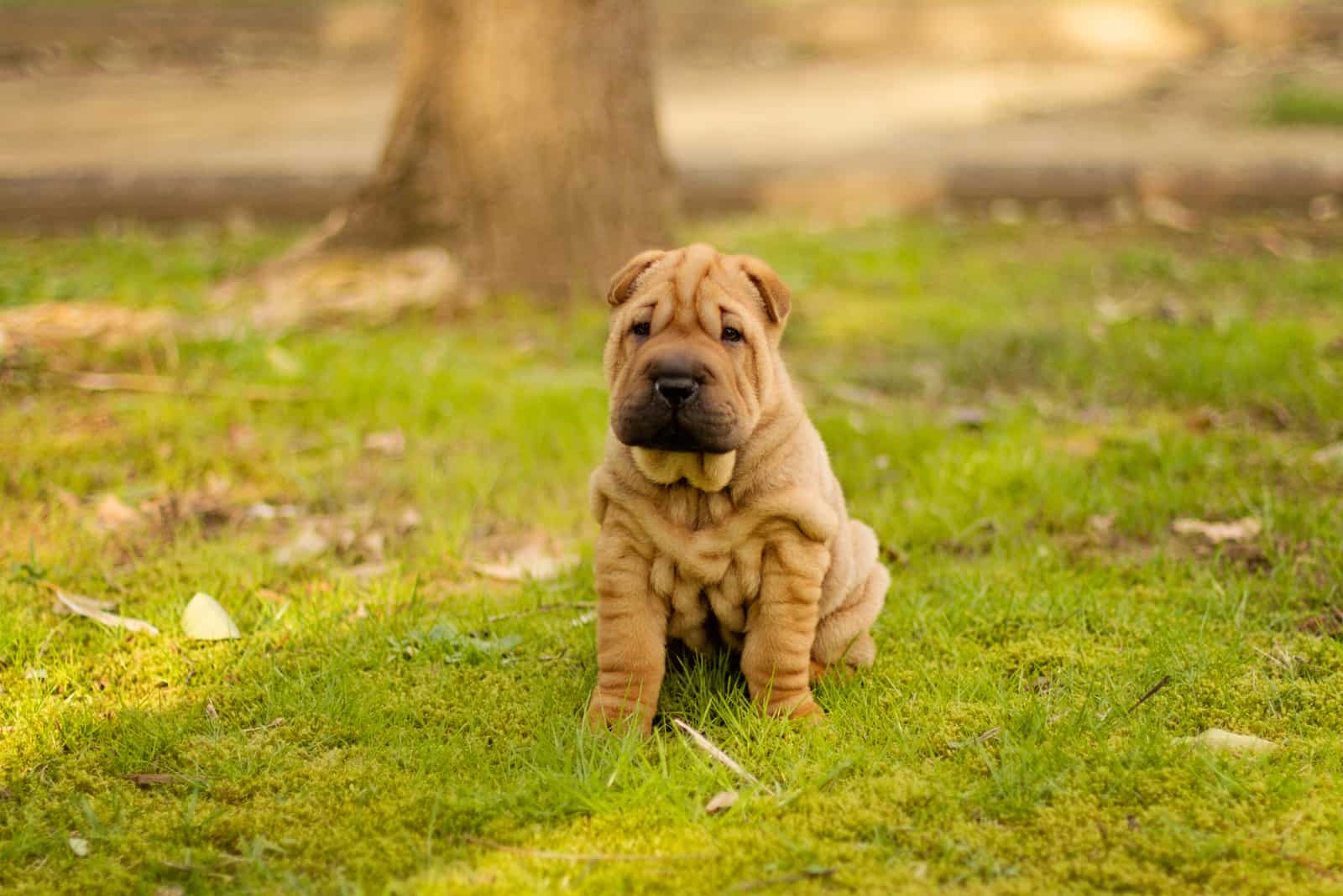
A Chinese Shar-Pei puppy will cost you between $750 and $1,800. The average puppy price is around $1000. First-year expenses can be quite overwhelming.
You can expect to pay around $2,835 for everything your dog needs. After that, the expenses will drop drastically to approximately $120 a month. Since most Shar-Peis have a short lifespan of around 10 years, the average cost of owning one of these dogs can sum up to $15,930.
These numbers are based on a list of all the necessities, from dog supplies to training, food, grooming, and medical bills. But, there’s always an unpredicted expense like spaying or neutering, which also costs money.
And, if you go all the way and spoil your Shar-Pei like crazy, the entire expenses list can climb up to an incredible number of $100,490 over 10 years!
Read More: Shar-Pei Cost: The Price Is Sharp, Eh?
Are Bear Coat Shar-Peis Good Dogs?
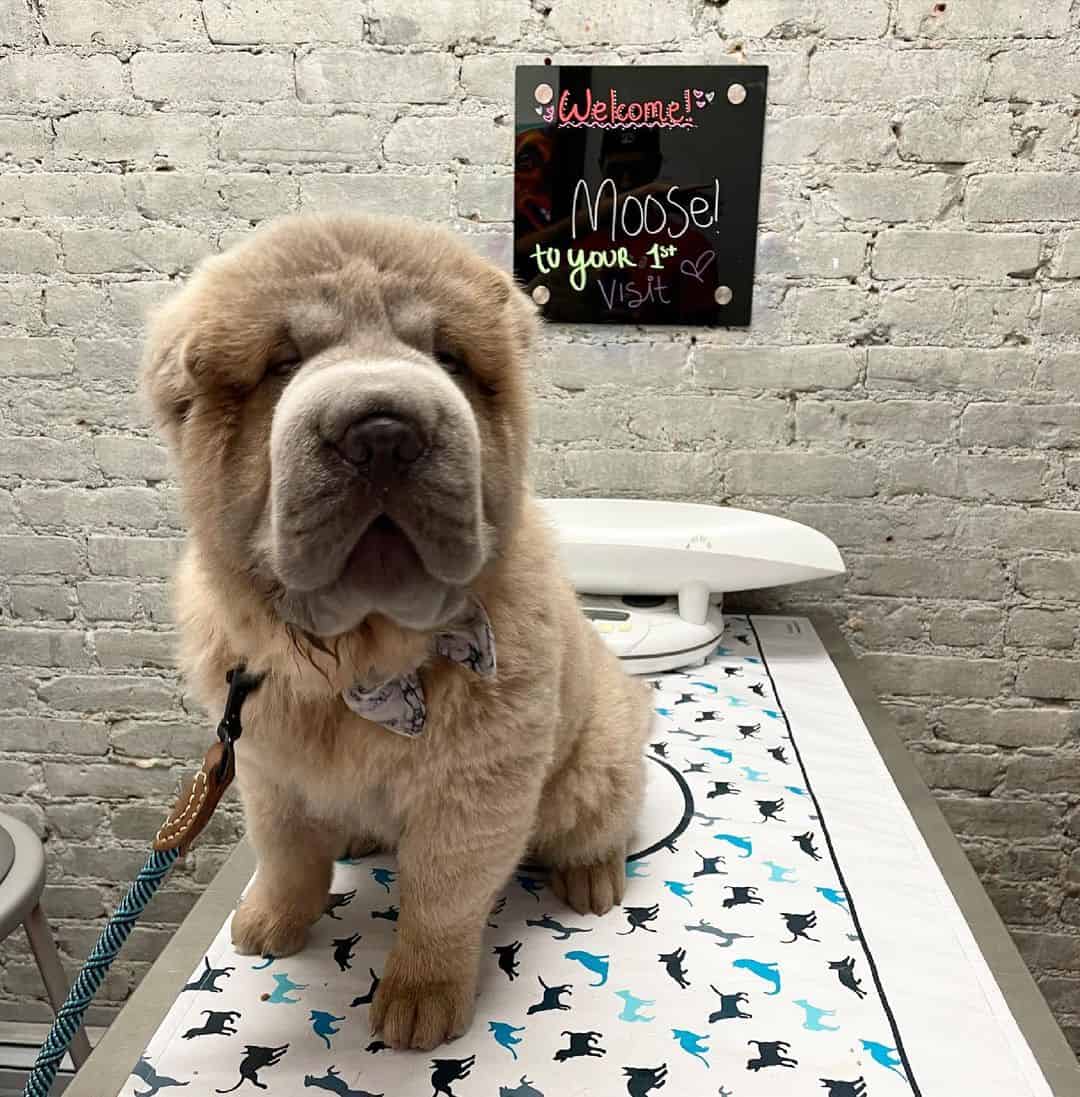
Photo from: @themoosebear
The Shar-Pei can be a loyal companion and your best friend, but it takes early socialization and proper training to get him there.
Before you bring one of these puppies home, there are some things you should consider. The bear coat Shar-Pei, as well as other Shar-Peis, no matter their coat length, don’t get along with other dogs, pets of any type, and even children.
Shar-Peis have herding tendencies that result in aggressive and protective behavior from time to time.
What’s even more concerning about the Shar-Pei breed is their long list of hereditary health problems. Expensive vet checkups are coming your way.
If you’re thinking about whether a puppy from a breeder or a rescued adult Shar-Pei is the dog for you, we’ve got your answer. Puppies are absolutely adorable, but raising them is hard, no matter how much it gets easier with time. Besides, you’ll be investing a bunch of money.
Adult dogs are an open book; you get what you see. Maybe getting an adult Shar-Pei would be ideal for you because you can see the kind of dog you’re actually getting?
Final Thoughts
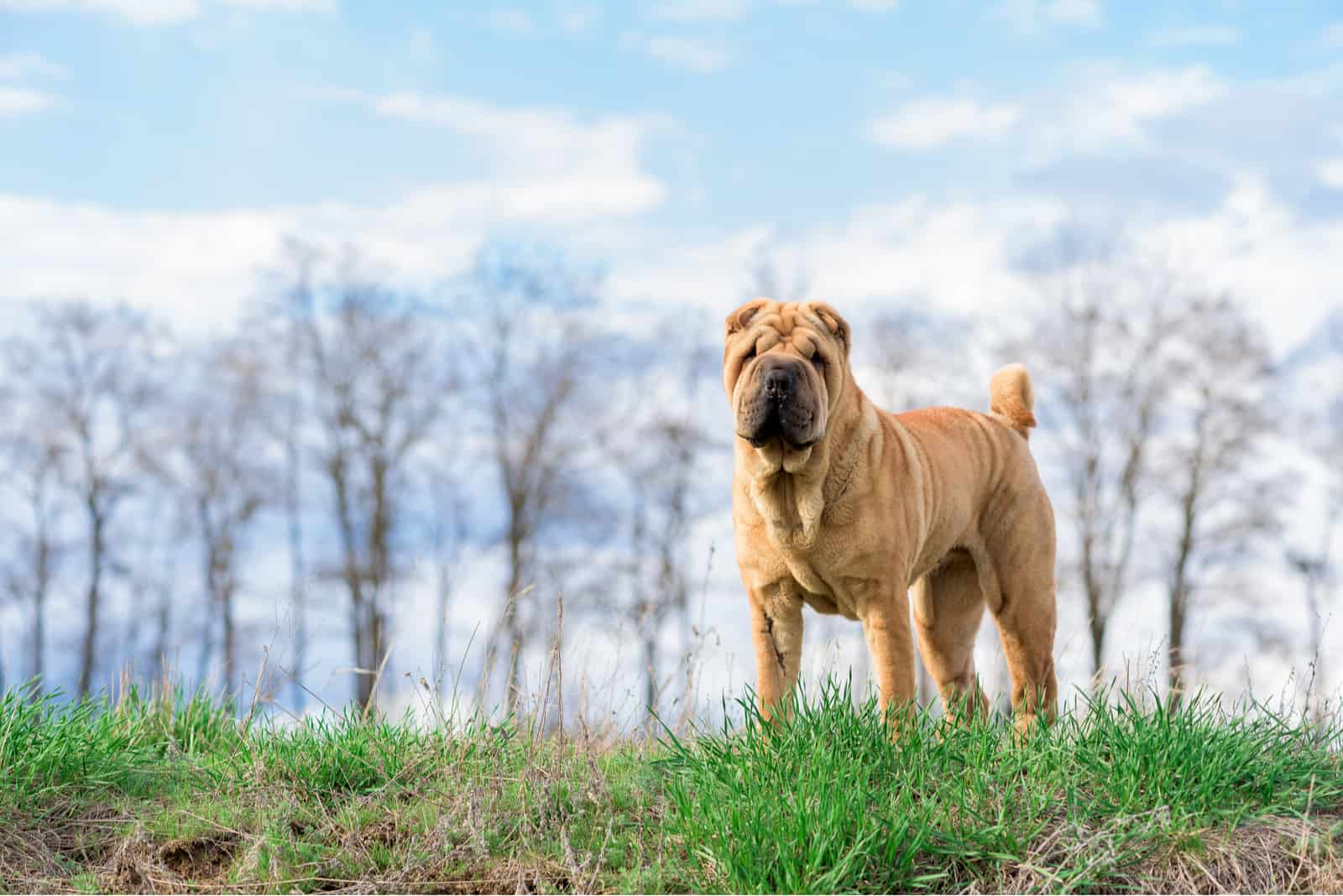
Shar-Peis are a really interesting breed with their unusual looks. What’s even more interesting is the wide range of Chinese Shar-pei colors. This hippo-looking dog with high-set eyes and loose skin has a coat color for everyone’s taste.
But, before you make a purchase, you should be aware that there is more to getting a Shar-pei than the 18 standard colors. You need to be introduced to the dog’s temperament.
If you accept the Shar-Pei the way he is, with all his flaws and positive aspects, deciding which color to choose should be easier than deciding which dog name to give him.
Read Next: The Miniature Shar Pei: Wrinkles That Captured The World















